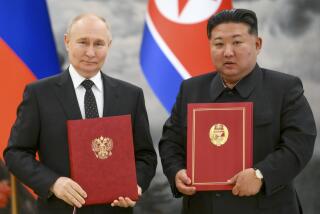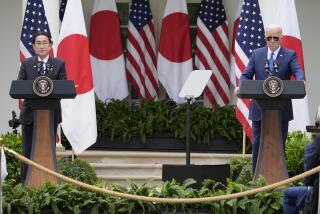The Paradigm of a Smart Deal : Is North Korea aiming at Osaka and Nagoya?
- Share via
The United States has made a very unusual offer to Japan: Trade American missile know-how for Japanese civilian/commercial technology. The novel technology swap would provide advanced Japanese commercial technology that would help U.S. industry, while Japan would secure U.S. help to build an anti-missile system as protection against regional threats-- namely North Korea.
NICE INITIATIVE: The intriguing initiative, presented by the Defense Department, comes just days before the first official meeting of President Clinton and Japanese Prime Minister Morihiro Hosokawa, in New York next week. It represents the Administration’s first effort to develop a new paradigm for strained U.S.-Japan relations. The aim is to fully integrate and better balance security and economic interests of the two nations.
The two history-conscious leaders share a desire to usher in a new era for the U.S.-Japan partnership. Chronic problems--especially the huge trade imbalance and market access--have strained relations between the nations. The potential for finding new ways to cooperate while working on remedies to these problems makes the technology swap worth pursuing. Though complicated and politically difficult in both countries, an exchange could be of mutual benefit.
John M. Deutch, undersecretary of defense for acquisition and technology, who met with officials of three Japanese ministries about the U.S. proposal, put it this way: “This is part of a larger initiative. One of the dangers for our national security is from economic weakness. We are actively looking for ways to use defense to encourage dual-use technology that serves military and civilian purposes.”
INVOLVING JAPAN: The United States is planning to spend $12 billion over the next five years to develop an advanced anti-missile system of its own and hopes to involve Japan in that program, known as Theater Missile Defense.
For Japan, access to such defense technology offers an alternative, short of developing its own nuclear weapons, for handling concerns about North Korea. In June, North Korea tested a Rodong-1 missile, capable of traveling 625 miles, or as far as western Japan. It is believed to be working on an improved version that could hit Osaka and Nagoya.
That said, precisely what commercial technology might the United States receive from Japan in return? It is one thing for governments to agree to exchange military and defense expertise but quite another to exchange private, proprietary and commercial technology. How would that be done, monitored and determined? Those questions and many, many more must be answered as this promising idea of exchanging technology is explored.
More to Read
Sign up for Essential California
The most important California stories and recommendations in your inbox every morning.
You may occasionally receive promotional content from the Los Angeles Times.













